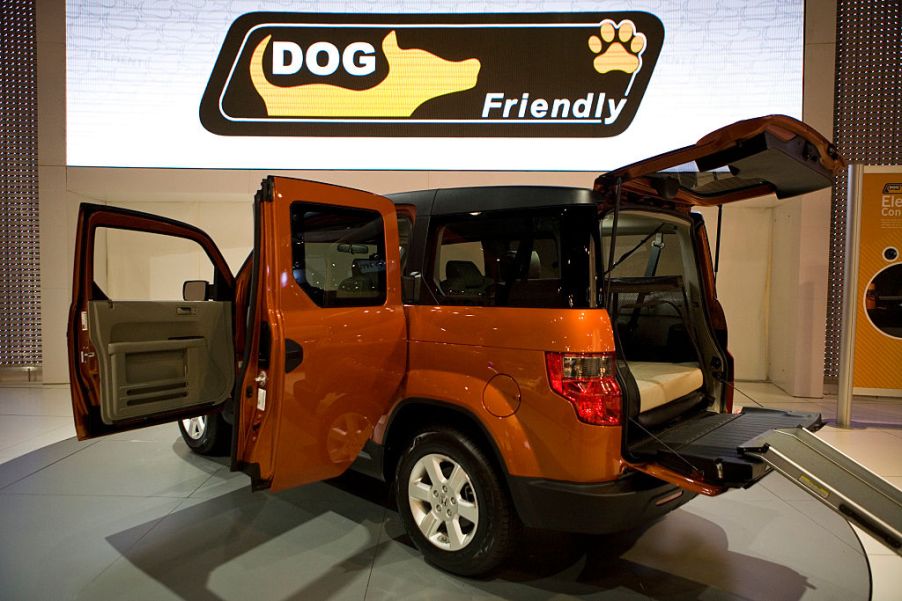
Why the Discontinued Honda Element Still Has a Cult Following
Once upon a time, Honda produced a legendary compact SUV that was practical, versatile, and quirky to boot. Its flexible utility, easy handling, and unusual profile made it stand out against its more conventional rivals the Jeep Compass, Nissan Rogue, and Ford Edge.
This storied SUV was the now-defunct Honda Element. Despite Honda’s decision to stop production of this idiosyncratic vehicle, it continues to be loved by a passionate group of enthusiasts. Here’s why the Element’s followers remain devoted to it.
The Toaster
Before small squarish cars and SUVs such as the Scion xB and the Kia Soul became cool, there was the Honda Element. Not only is it boxy, but it also measures over 70 inches tall and had a wheelbase of only 101 inches.
It was based on the Honda CR-V platform. But you wouldn’t know that by looking at its curved roofline inspired by the shape of a surfboard and its decidedly un-aerodynamic profile.
Dimensions such as these gave the Element a distinct resemblance to a toaster, as owners affectionately dubbed it. Other nicknames were “the pie wagon” and “the boxcar”.
But the Honda Element offered far more utility than a simple box on wheels would. It was configured with five doors, and large cargo could be easily loaded from the side because it had biparting front and rear doors. It was designed so that you’d first have to open the front doors before opening the outward-swinging rear doors. And the maximum cargo space without its removable seats added up to an amazing 74.6 cubic feet.
The back seats could also be folded individually into a flat, horizontal position, so the Element’s occupants could sleep on them if they wanted. They also could be stowed up on the sides of the cargo area.
Perfect for the outdoors
Another aspect of this SUV’s outdoorsy, camper van aura is that some earlier variants came with a manual sunroof over the rear cargo area. The sunroof could be removed and tall, slender cargo like surfboards or skis perhaps, could poke out of the top of the Element.
Owners who hauled kids, dogs, or messy cargo loved the Honda’s stain-resistant upholstery and industrial-grade, textured urethane flooring. Unlike the flooring on the Jeep Gladiator, though, it can’t be hosed out. But it can be easily wiped off.
The Element was equipped with a 2.4-liter four-cylinder engine that produced 166 hp and 160 lb-ft, paired with either a five-speed manual or five-speed automatic transmission. Buyers could choose between front-wheel drive or a real-time four-wheel drive. It also had a towing capacity of 1,500 pounds — perfect for a small camper or a bike trailer.
The brief lifespan of the Honda Element
The Element had just one generation. It rolled out of the factory in late 2002, and the last model was made in late 2010 for the 2011 model year. Over those years, Honda refreshed it and added and subtracted trim levels. But only about 325,000 of these SUVs were sold. The Element never became a big seller the way the Civic or the Accord did.
According to Alex Taylor III of Forbes.com, Honda designed the Element for young people who enjoyed active lifestyles. It seemed like an ideal fit, but Honda targeted the wrong generation because people over 35 were buying Elements.
To make matters worse, the more conventional CR-V had more buyer appeal because it got better fuel economy, was more driveable, and could hold an additional passenger.
Honda came to the realization that it made a miscalculation by designing a niche vehicle and cut its losses after eight years of dwindling sales. And the automaker didn’t anticipate that the Element’s targeted buyers didn’t have the money to buy it.
Honda not only missed the mark with this demographic but it also stumbled in keeping the older buyers the Element did attract. For those reasons it was doomed.
Why the Honda Element still has many fans
In a broad stroke of irony, the Honda Element has recently become something of a cult classic. It was a little too far ahead of its time in 2003, but now its fans have caught up. Here are some reasons why they love it.
The Element handles reasonably well for a box on wheels, and it has a small footprint for parking. Its novel configuration makes it easy to load large, odd-shaped cargo. And it has an immediately recognizable profile. These features have great appeal for many owners.
Some fans take their Elements on camping, biking, or surfing trips, just as Honda’s designers intended. There’s plenty of space in the rear for any kind of sports equipment, including bigger stuff like a Honda Grom or kitesurfing gear.
The Element’s roominess also has made fans out of delivery folks, service people, musicians, and artists. It’s a proven kid and dog mover as well. Enthusiasts of the Element appreciate its versatility, utility and, yes, its eccentricities. So, the question on many fans’ minds is: will Honda bring the Toaster back? We hope so, and soon.


